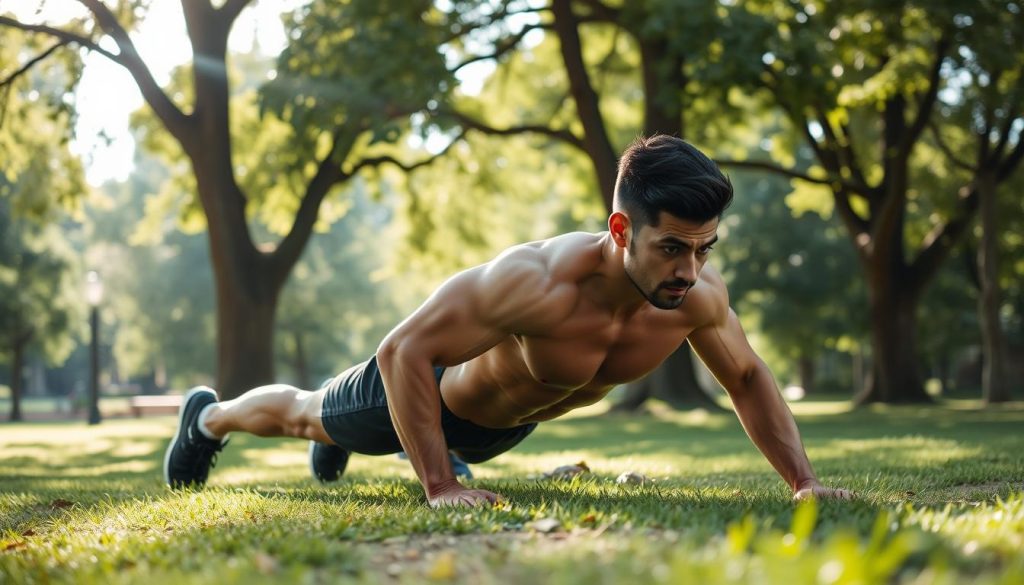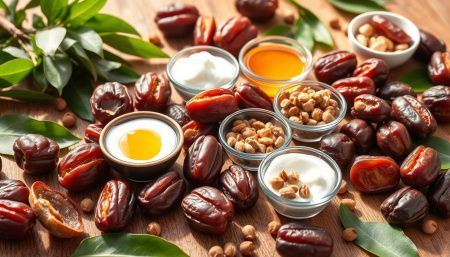Many think gaining muscle means lifting heavy weights. But, is that the only way? With gyms not always accessible, people seek ways to build mass without weights. This article explores new ways to grow muscle using body weight and gravity.
Fitness lovers and athletes alike wonder about building mass without weights. We’ll look at science-backed methods for muscle growth without gym equipment. You can achieve muscle growth at home, outdoors, or anywhere with limited space. Get ready to change your body with the right knowledge and exercises.
Understanding Muscle Growth: Bodyweight Training Basics
Starting a journey to grow muscle with bodyweight exercises means learning key hypertrophy principles. These include progressive overload. This method is key for building strength without needing gym equipment.
Principles of Hypertrophy Without Weights
Hypertrophy, or muscle growth, is often linked with weightlifting. But, it’s also possible with bodyweight exercises if done right. These exercises focus on muscle tension, metabolic stress, and damage. They help increase muscle strain and endurance.
Progressive Overload with Bodyweight Exercises
Progressive overload is vital for muscle growth. In bodyweight training, it’s done by changing exercise intensity and complexity. For example, moving from a regular push-up to a one-arm push-up boosts muscle strength and size.
| Exercise | Standard Version | Progressed Version |
|---|---|---|
| Push-ups | Regular Push-up | Archer Push-up |
| Pull-ups | Standard Pull-up | L-sit Pull-up |
| Squats | Bodyweight Squat | Pistol Squat |
The Science Behind Muscle Building Without Lifting Weights
Looking into muscle building without lifting weights shows how our bodies can adapt. This adaptation comes from stress like muscle tension and damage. These can be caused by bodyweight resistance training.
Understanding muscle tension is key. Bodyweight exercises like push-ups and planks create tension. This tension is vital for muscle growth, similar to weightlifting.
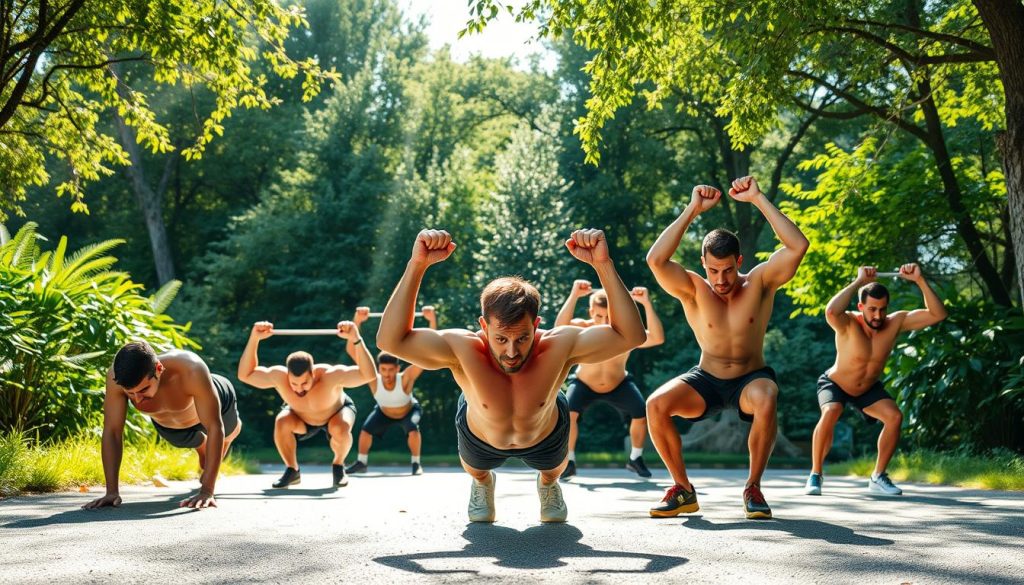
Bodyweight resistance training also causes muscle damage. This damage leads to muscle repair and growth. Exercises like deep squats push muscles to their limits, helping them adapt.
Metabolic stress is another important factor. It comes from exercise by-products like lactate. Bodyweight training can create this stress, similar to weightlifting.
Here’s a look at muscle activation levels in weightlifting and bodyweight exercises. It shows bodyweight exercises can build muscle effectively:
| Exercise | Traditional Weightlifting | Bodyweight Exercise |
|---|---|---|
| Chest Press vs. Push-Up | High | Moderate to High |
| Leg Press vs. Squat | High | High |
| Shoulder Press vs. Handstand Push-Up | High | Moderate to High |
| Pull-Up (Assisted) vs. Pull-Up | Moderate | High |
These comparisons show muscle growth isn’t just for weightlifting. Muscle building without lifting weights can also work. It uses our body’s natural ability to adapt and grow.
Can You Gain Muscle Without Lifting Weights?
Many people are now using bodyweight exercises to build muscle. Their success shows a big change in how we see strength training. Looking at real-life muscle gain examples and evidence-based bodyweight training methods can inspire and teach us a lot.
Real-Life Success Stories
There are interesting answers to the question of gaining muscle without weights. An ultra-endurance athlete, for example, got stronger and more toned by doing push-ups, pull-ups, and planks. His story shows how success with bodyweight exercises can lead to great results with the right plan.
A former weightlifter also found success with bodyweight workouts after an injury. She did modified squats, lunges, and dips for months. Her muscle mass stayed the same or even grew. These real-life muscle gain examples prove that bodyweight routines can be very effective.
Physiological Evidence Supporting Bodyweight Training
Science backs up the benefits of bodyweight training. Studies show how bodyweight exercises change muscle fibers. This evidence-based bodyweight training shows that you don’t need to lift heavy weights to build muscle.
Researchers found that changing bodyweight exercises can keep muscles challenged. This leads to growth similar to weightlifting. These findings help improve training methods and encourage more people to try bodyweight exercises.
In the end, you can grow muscle whether you’re at the gym or at home. The secret is to use well-structured, progressive bodyweight workouts. These workouts should effectively stimulate muscle growth.
Advanced Bodyweight Exercises for Muscle Gain
Looking to build muscle with bodyweight muscle building? Adding advanced bodyweight exercises to your workouts is key. These exercises push your body in new ways and help you build muscle efficiently. We’ll look at some tough bodyweight exercises that target different muscle groups for growth.
Exercises like one-arm push-ups, pistol squats, and handstand push-ups make workouts harder. They help your muscles get stronger and grow. These exercises help you achieve progressive overload without weights. To keep getting stronger, try scaling or changing these exercises to keep challenging your muscles.
- One-Arm Push-Ups – Boost upper body strength and core stability by focusing on one arm.
- Pistol Squats – Work the legs, including quadriceps, hamstrings, and glutes, for lower-body strength.
- Handstand Push-Ups – Focus on shoulders and triceps, also engaging the core for stability.
These advanced bodyweight exercises do more than build muscle strength. They also improve balance, agility, and coordination. They’re a complete fitness approach. Beginners might find them tough, but with practice and the right form, you can master them.
| Exercise | Primary Muscles Worked | Benefits |
|---|---|---|
| One-Arm Push-Ups | Chest, shoulders, core | Improves muscular imbalance, enhances core strength |
| Pistol Squats | Legs, mainly quadriceps | Boosts balance, increases lower body strength |
| Handstand Push-Ups | Shoulders, triceps, core | Increases upper body strength, improves body awareness |
In conclusion, adding these challenging bodyweight movements to your routine helps with bodyweight muscle building. It also leads to a well-rounded fitness that goes beyond just muscle growth.
Designing a Muscle-Building Bodyweight Routine
Creating a bodyweight workout routine for muscle growth needs a smart plan. It should focus on how often you work out, the number of exercises, and how hard you push yourself. This is true for both beginners and those looking to improve their routine.
Frequency and Volume for Optimal Muscle Growth
Finding the right mix of workout frequency and volume is key. This balance helps grow muscles without overdoing it.
- Muscle growth frequency is how often you work each muscle group.
- Workout volume is the total number of exercises, sets, and reps for each group.
A good routine might hit each major muscle group two to three times a week. It should be intense enough to challenge the muscles, leading to growth and strength.
Incorporating Variety and Intensity Techniques
To keep challenging your body and encourage muscle growth, mix up your routine. Use different exercise intensity techniques. These methods keep muscles under tension in various ways, which is good for growth.
- Changing the tempo of exercises can modify how muscle fibers are engaged.
- Adding pauses at the peak of an exercise increases time under tension, a key factor in muscle growth.
- Trying different angles helps target muscles in unique ways, ensuring all fibers are activated.
| Technique | Description | Benefits |
|---|---|---|
| Tempo Changes | Altering the speed of exercise execution | Increases muscle time under tension, boosting growth |
| Pauses | Incorporating stops at the height of movement | Intensifies focus on muscle engagement |
| Angle Adjustments | Performing exercises in various angles | Ensures full muscle fiber recruitment |
Muscle Gain Without Weights: Nutrition and Recovery
To gain muscle without weights, focus on diet and muscle building and muscle recovery. Nutrition and rest work together to improve muscle function and growth. This is key for weight-free training.
The Role of Diet in Muscle Gain
Nutrition for muscle gain is vital. You need a diet rich in calories and protein. Proteins help repair and grow muscles, important for strength training.
- Lean meats such as chicken, turkey, and fish
- Plant-based proteins like lentils, beans, and tofu
- Ample healthy fats from sources such as avocados, nuts, and seeds
- Complex carbohydrates like whole grains, oatmeal, and sweet potatoes
These foods fuel your body for tough workouts and help with muscle recovery.
Importance of Rest Days for Muscle Recovery
Rest days are key for muscle gain. They let muscles repair and get stronger. Sleep is also critical for muscle recovery. Adults should sleep 7-9 hours a night.
Rest days are not just for the body but also for the mind. They’re vital for lasting fitness success.
In summary, combining diet and muscle building with rest days boosts muscle gain without weights. Knowing and using these tips is essential for muscle growth and fitness.
Comparing Bodyweight Training to Traditional Weightlifting
In today’s fitness world, it’s key to know the resistance training comparisons between bodyweight training benefits and traditional weightlifting. Both have their own perks and can meet different fitness needs and lifestyles.
Bodyweight exercises are super convenient. You don’t need fancy gear or gym memberships. They focus on flexibility and endurance, boosting your daily fitness. Plus, they’re safer than lifting heavy weights.
Traditional weightlifting, though, is great for building strength and muscle. It lets you increase weight and target muscles well. For big muscle gains, weightlifting is often the best choice.
| Training Type | Benefits | Ideal For |
|---|---|---|
| Bodyweight Training | Cost-effective, flexible, lower injury risk | Endurance, functional fitness, general health |
| Traditional Weightlifting | Maximum strength, targeted muscle growth | Bulking up, competitive lifting, rapid strength gains |
Bodyweight training is great for keeping muscles strong over time. It’s adaptable, which is good for long-term fitness. But, if you want to build the most muscle, traditional weightlifting might be better.
Both methods are important for a well-rounded fitness plan. Your choice depends on your goals, lifestyle, and what you have available. Making the right choice can help you stay healthy and fit.
Making the Most of Resistance Training Alternatives
The fitness world keeps changing, and so do the tools and methods for getting stronger. If you’re looking for new ways to work out, try using resistance bands and DIY gym gear. These can make your home workouts just as good as going to the gym, without needing heavy weights or machines.
Using Resistance Bands to Enhance Bodyweight Exercises
Resistance bands are a great choice for adding weight to your bodyweight exercises. They come in different strengths, fitting for everyone from beginners to pros. They’re perfect for squats, presses, and curls, helping you get stronger and build muscle.
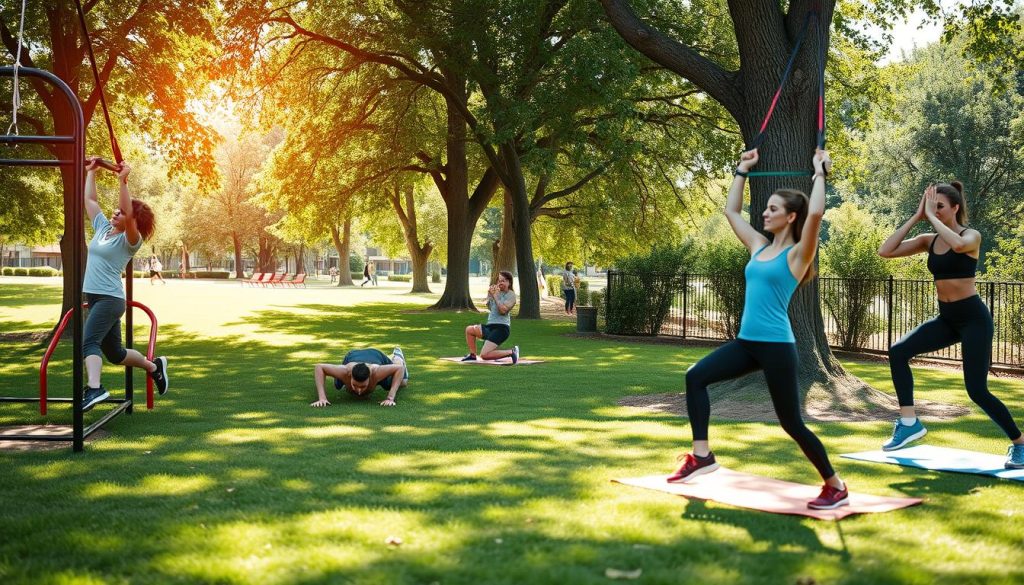
Creating Resistance with Improvised Household Items
You don’t need fancy gym gear to get fit. Everyday items can be just as good. For example, water jugs can be dumbbells, and a sturdy chair can help with tricep dips. Here’s how to use things you already have:
- Water Jugs: Great for bicep curls or frontal raises.
- Backpacks: Fill with books for extra weight in squats or lunges.
- Towels: Use as sliders for abs or to make leg exercises harder.
These alternatives not only offer a new challenge but also keep workouts fun and varied. Using resistance bands and DIY gym gear means you can keep getting better, stay excited about your fitness goals, and do it all from home.
Targeting Major Muscle Groups Without Gym Equipment
Creating a good home workout to hit major muscle groups without gym equipment alternatives is doable and rewarding. It’s important to work all key muscle areas—upper body, core, and lower body. This way, you get muscle balance and strength.
This section will list and define key major muscle groups. It will also suggest bodyweight exercises as good gym equipment alternatives for each group:
- Chest and Shoulders: Push-ups and their variations like incline and decline push-ups work these muscles well.
- Back: Pull-ups and chin-ups, if a bar is available, or towel rows using a sturdy towel and a door, can significantly benefit back muscles.
- Arms: Tricep dips on a chair and bicep curls with resistance bands foster arm strength and growth.
- Core: Plank variations and leg raises offer a deep engagement of the entire core region.
- Legs: Squats, lunges, and step-ups target the quadriceps, hamstrings, and calves without any weights.
Adding these exercises to your routine can make a full home workout. It covers all major muscle groups, boosting muscle endurance and growth even without gym equipment.
| Muscle Group | Bodyweight Exercise | Benefits |
|---|---|---|
| Chest & Shoulders | Push-ups, Incline Push-ups | Builds upper body strength, improves muscular endurance |
| Back | Pull-ups, Towel Rows | Enhances back muscle mass, aids in posture correction |
| Arms | Tricep Dips, Bicep Curls with Bands | Tones arm muscles, increases arm strength |
| Core | Planks, Leg Raises | Strengthens the abdominal region, supports spinal and pelvic alignment |
| Legs | Squats, Lunges | Promotes lower body strength, enhances flexibility and balance |
Adding these movements to your routine ensures all major muscle groups are challenged. This leads to balanced muscle growth and better health, all without gym equipment.
Myths and Misconceptions about Bodyweight Muscle Building
Bodyweight training is popular, but myths surround it. These myths make people think it’s hard to build muscle without weights. The idea of hitting a bodyweight plateau also scares many off.
Debunking the Idea that Weights Are Necessary for Mass
Many believe you need weights to build muscle. But studies and real results show bodyweight exercises can build muscle too. The trick is to keep making exercises harder and more intense.
Try moving from regular push-ups to one-armed push-ups. Or, use elevated legs to make exercises more challenging.
Addressing the Plateau Myth in Bodyweight Training
The bodyweight plateau myth says gains stop after a while. But this can happen with any workout if it doesn’t change. To beat a plateau, try new exercises, increase reps, or change how fast you do them.
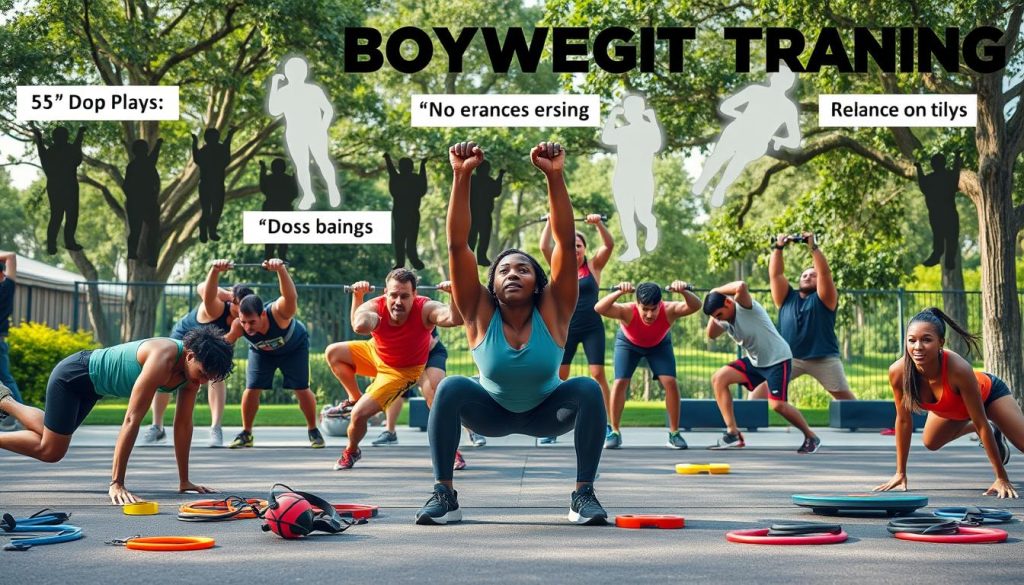
Knowing these facts can help clear up myths about bodyweight training. It shows you can build muscle without weights. By trying new things and making exercises harder, you can keep growing your muscles.
How to Build Muscle without Weights for Different Fitness Levels
Everyone can build muscle for all fitness levels with tailored bodyweight training. This method lets you adjust exercises for beginners, intermediates, and advanced people. It ensures you keep getting stronger and your workouts stay interesting.
Beginners should start with simple exercises. These help build stability and endurance while growing muscles. It’s key to focus on getting the form right before making the workouts harder.
As you get stronger, add more challenging exercises. This keeps your muscles growing and your workouts exciting.
Intermediate folks can try doing more reps or adding dynamic moves. These changes keep your muscles growing as your body gets used to the workouts.
Advanced people can do high-intensity workouts and complex moves. These exercises not only grow muscles but also improve coordination and athletic skills.
| Fitness Level | Exercise Variation | Intensity Modification | Progress Indicators |
|---|---|---|---|
| Beginner | Standard push-ups, squats | Gradual increase in reps | Increased ease of performing basic exercises |
| Intermediate | Decline push-ups, pistol squats | Addition of dynamic movements | Ability to perform more complex movements |
| Advanced | One-hand push-ups, jump squats | High-intensity interval training (HIIT) | Mastery in executing high-intensity exercises |
It’s important to track your fitness progression. Set goals and change your workout intensity based on how you’re doing. These goals help guide your training and show how far you’ve come.
By following these tips, you can build muscle for all fitness levels with tailored bodyweight training. Keep challenging yourself and enjoy the journey to becoming stronger and healthier.
Strength Training Without Weights: Safety and Injury Prevention
It’s important to focus on safe strength training when you don’t use weights. This method lowers injury risk and keeps your fitness journey going. Let’s explore how to stay safe and effective in strength training without weights.
Proper Form and Technique to Avoid Injury
Keeping the right exercise form is key, even without weights. Bodyweight exercises can be tough and need careful attention to avoid injuries. Here are some tips:
- Always warm up before starting to get your muscles and joints ready.
- Do exercises in front of a mirror to check your alignment and adjust as needed.
- Get help from a fitness expert to learn the right techniques and form.
- Do exercises slowly and in control to work your muscles better and avoid strain.
Listening to Your Body and Adjusting Workouts
Being able to adjust your workouts based on how your body feels is important for injury prevention. Ignoring pain can lead to serious injuries and stop your progress. Here are some important points:
- Lower the intensity or change exercises if you feel pain that’s not just muscle fatigue.
- Take extra rest days if you need them, after hard workouts.
- Drink plenty of water and eat well to help your muscles heal and grow.
- Use pain and discomfort to check if you need to change your workout plan.
Changing your routine when needed shows you care about your long-term health and fitness.
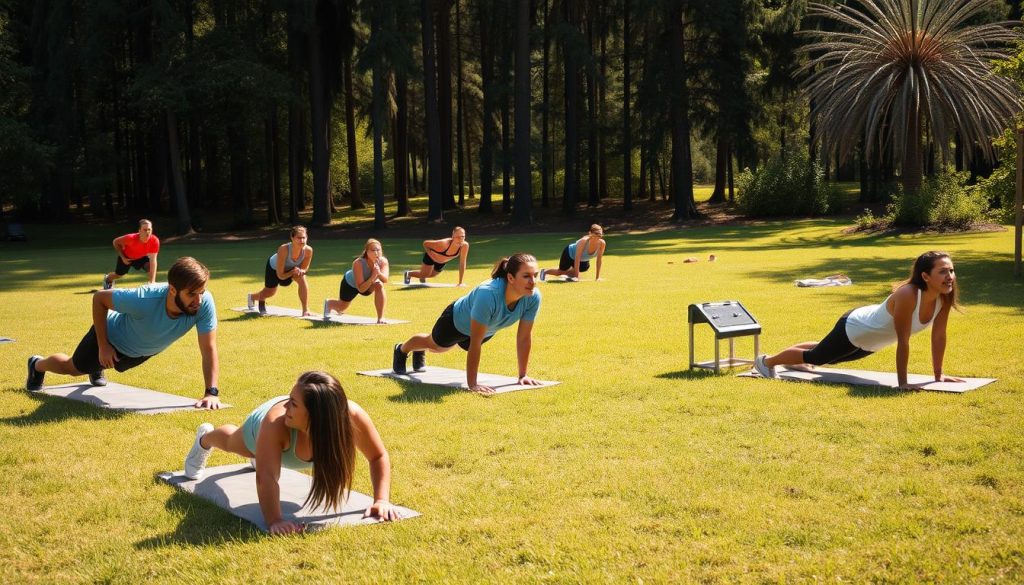
| Area of Focus | Technique Tip | Reason for Importance |
|---|---|---|
| Core Strength | Engage your abdomen throughout exercises | Prevents lower back injuries |
| Lower Body | Keep knees aligned with toes during squats | Avoids undue strain on knee joints |
| Upper Body | Ensure wrists are straight in push-ups | Protects wrist joints from stress |
Using these tips in your routine makes your workouts safer and more effective. Remember, steady strength gains come from paying attention to form and listening to your body.
Staying Motivated and Tracking Progress Without the Scale
Starting a fitness journey without a scale can be tough. It’s hard to keep going without seeing numbers change. But, setting clear goals helps a lot. Every small win, like mastering a new exercise or doing more reps, is a big deal.
By celebrating these wins, you boost your motivation. It’s like a positive cycle that keeps you going.
It’s also key to find ways to measure your progress. Instead of just looking at the scale, try tracking body measurements and how well you do in workouts. Seeing how your clothes fit or how strong you get can show you’re making progress.
These signs of success are often more meaningful than just losing weight. They show the real changes in your health and fitness.
Stories of people like Jonah Hill losing weight in a healthy way are very inspiring. They show that success is not just about the number on the scale. It’s about feeling better, sleeping better, and being happier.
This way of thinking makes fitness more than just about losing weight. It’s about living a healthier, happier life. This mindset helps you stay dedicated to your fitness goals for the long haul.
FAQ
Q: Can you really gain muscle without lifting weights?
A: Yes, you can gain muscle without weights. Use bodyweight exercises and focus on muscle growth. This approach works well.
Q: What are the principles of hypertrophy when it comes to bodyweight training?
A: Hypertrophy in bodyweight training involves muscle tension, damage, and metabolic stress. These can be achieved through progressive overload.
Q: Can bodyweight exercises provide enough resistance for muscle growth?
A: Yes, bodyweight exercises can offer enough resistance for muscle growth. Increase difficulty by changing leverage, tempo, and adding unilateral movements.
Q: Are there real-life success stories of people building muscle without weights?
A: Yes, many have built muscle using bodyweight exercises alone. Their success stories show the effectiveness of this method.
Q: What advanced bodyweight exercises are most effective for muscle gain?
A: Exercises like one-arm push-ups, pistol squats, handstand push-ups, and pull-ups are effective. They require proper technique and intensity.
Q: How often should I perform bodyweight exercises to build muscle?
A: Aim for 2-4 times a week for muscle growth. This allows for enough rest, based on your fitness and recovery.
Q: How important is nutrition in a muscle-building program that doesn’t involve weights?
A: Nutrition is key in any muscle-building program. Eat plenty of protein, balanced carbs and fats, and enough calories for muscle repair and growth.
Q: Can bodyweight training be as effective as traditional weightlifting for muscle gain?
A: Bodyweight training can be as effective as weightlifting for muscle gain. It’s important to challenge muscles progressively.
Q: Are there benefits to incorporating resistance bands or household items into a bodyweight routine?
A: Yes, adding resistance bands or household items can challenge muscles more. It simulates weightlifting and helps in muscle growth.
Q: How can I target all major muscle groups without gym equipment?
A: Use exercises like push-ups, squats, lunges, dips, and planks. They effectively target major muscle groups without gym equipment.
Q: Do you need weights to achieve significant muscle mass?
A: No, you don’t need weights for significant muscle mass. Strategic bodyweight training focusing on overload and intensity works well.
Q: How can bodyweight training intensity be scaled for different fitness levels?
A: Scale intensity by modifying exercises, adjusting volume and tempo, and using advanced techniques. This matches individual fitness levels.
Q: What are some safety tips for strength training without weights?
A: Ensure proper form and technique. Listen to your body to avoid injury. Consider consulting certified trainers or physiotherapists for guidance.
Q: Beside muscle mass, what other indicators should I track for fitness progress?
A: Track performance improvements, body measurements, increased strength, endurance, and overall wellness. These show progress in a weight-free fitness routine.












